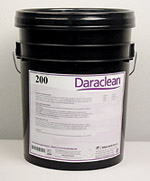The Daraclean Advantage:
Water-Based vs. Solvent-Based Metalworking Cleaners
Chlorinated solvent systems have been used for many years by the metalworking industry to remove cutting oils and shop dirt from machined parts. Cleaning is necessary to enable part inspection and ease of handling as well as to prepare the part for subsequent processing. Parts cleaning is especially critical prior to plating or painting operations since any soil can interfere with the surface treatment process.
With the availability of efficient Daraclean water-based cleaners, many reasons exist to choose such products over solvent-based alternatives. The following describes the technical and regulatory advantages of using water-based cleaners.
Technical Advantage of Daraclean Aqueous Cleaners
1. Cleaner Fluid Handling is Simplified - Daraclean cleaners can be used in soak, agitation, ultrasonic or spray applications at room temperature or at elevated temperatures. Unlike chlorinated solvents which must be heated to greater than 160°F to produce vapors for vapor degreasing, Daraclean works well at 120-160°F in most applications. Spray applications may require higher temperatures for foam control.
 Daraclean aqueous products are alkaline detergents for parts cleaning and work as well as chlorinated solvents in most applications. Daraclean products lift tough soils and oils from part surfaces. The solution then rejects these oils causing them to float or settle out, where they are easily removed by overflow, skimming, filtration or absorbed by 'Tramp Off' blankets (square pads containing oil absorbing beads). This will greatly extend the cleaner tank life.
Daraclean aqueous products are alkaline detergents for parts cleaning and work as well as chlorinated solvents in most applications. Daraclean products lift tough soils and oils from part surfaces. The solution then rejects these oils causing them to float or settle out, where they are easily removed by overflow, skimming, filtration or absorbed by 'Tramp Off' blankets (square pads containing oil absorbing beads). This will greatly extend the cleaner tank life.
The use of water-based cleaners requires some retraining of operating procedures. Water does not evaporate as quickly as solvents, therefore parts are handled in a wet state. However the chemistry of Daraclean allows for rapid drying. In some cases plant air from nearby machines can be used to blow dry the parts. As a general rule, as temperatures are increased, drying times are decreased.
2. Process Steps Can Be Eliminated - Once a part has been cleaned with Daraclean water-based cleaners, it can usually be plated or painted with no further cleaning necessary. Flash rust, a familiar problem with chlorinated solvents, is totally eliminated by a built-in corrosion inhibitor in Daraclean, which can be removed by a water rinse if desired. In most cases this inhibitor does not have to be removed prior to subsequent metal finishing operations.
3. Daraclean Cleaners Eliminate Organic Acid Corrosion - A further benefit of water-based cleaners is that incoming water from water-diluted coolants is not a contaminant. By sharp contrast, such 'tramp' water entering a chlorinated solvent system has been known to cause the production of organic acids, which can spoil the cleaner and cause corrosion to parts and equipment.
Regulatory Compliance Aspects Eased With Water-Based Cleaners
1. No Solvent Vapors To Control With Water-Based Cleaners - Under the Occupational Safety and Health Administration (OSHA), there are worker vapor exposure limitations for virtually all solvents used in solvent-based cleaners. These maximum exposure limits are in units including 8-hour time weighted averages and 15-minute short term exposure levels. In order to maintain a safe and compliant work environment, users of chlorinated solvents must evaluate and control employee exposures to below the exposure limits. Evaluation includes documentation that monitoring programs are in place. Control includes appropriate ventilation and/or respirator use and respiratory protection programs.
Water-based cleaners do not contain solvents to control and under most conditions of use do not become airborne. In certain operations, like spray applications where mists may be generated, ventilation mat be required.
2. Hazardous Waste Minimization Efforts Assisted Using Daraclean Cleaners - Since Daraclean cleaners are 'self-cleaning', the fluids can last much longer than solvent or emulsion cleaners. This greatly reduces the amount of fluid gallons which must be disposed of. In addition, virtually all solvent-based cleaners are hazardous wastes as defined by the U.S. Environmental Protection Agency (EPA). Daraclean cleaners are not hazardous wastes as defined by the U.S. EPA after little, or in most cases, no pH neutralization.
3. Disposal Costs Reduced Using Daraclean Cleaners - Pretreated water-based cleaner wastes are often sewerable. Pretreatment procedures can include skimming and/or filtering, followed by pH neutralization. Sewerability is determined by the Municipal Sewer District covering the plant location.
Virtually all solvent-based cleaner wastes are regulated by Federal law. Disposal costs for incineration of such wastes are high and will continue to increase. Other methods of disposal for these hazardous wastes, including solvent reclamation involve significant costs as well.
